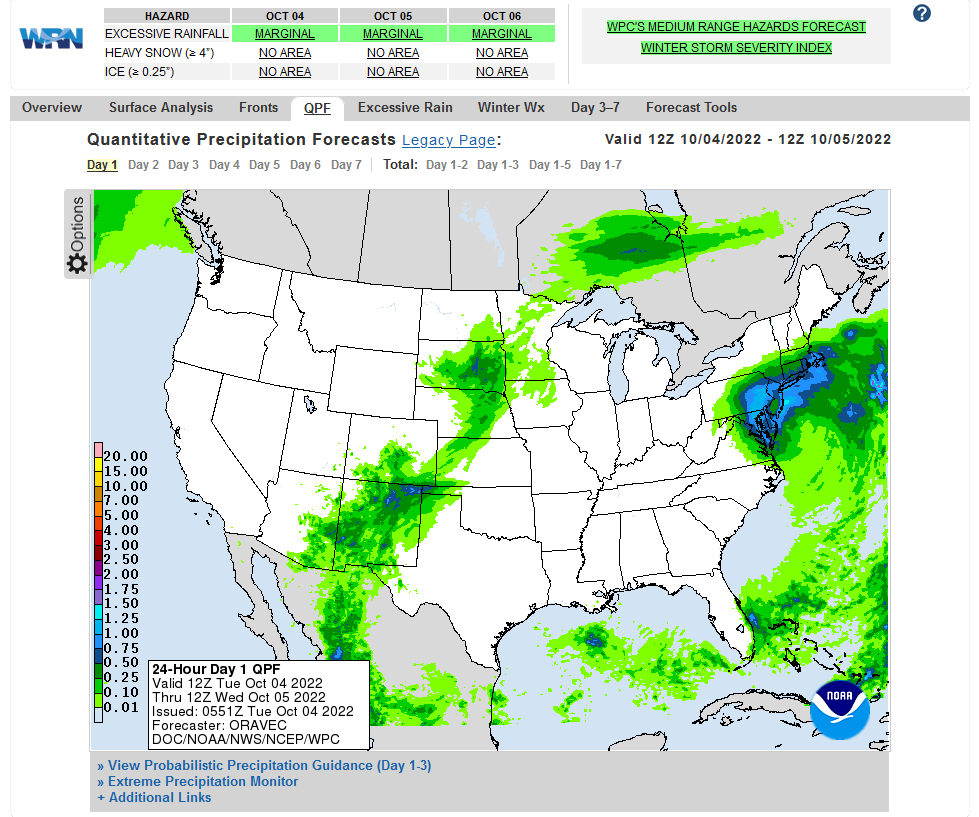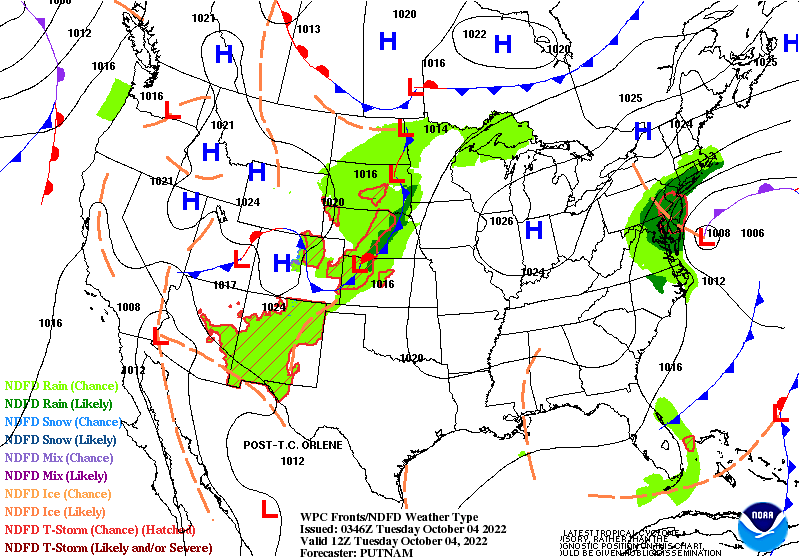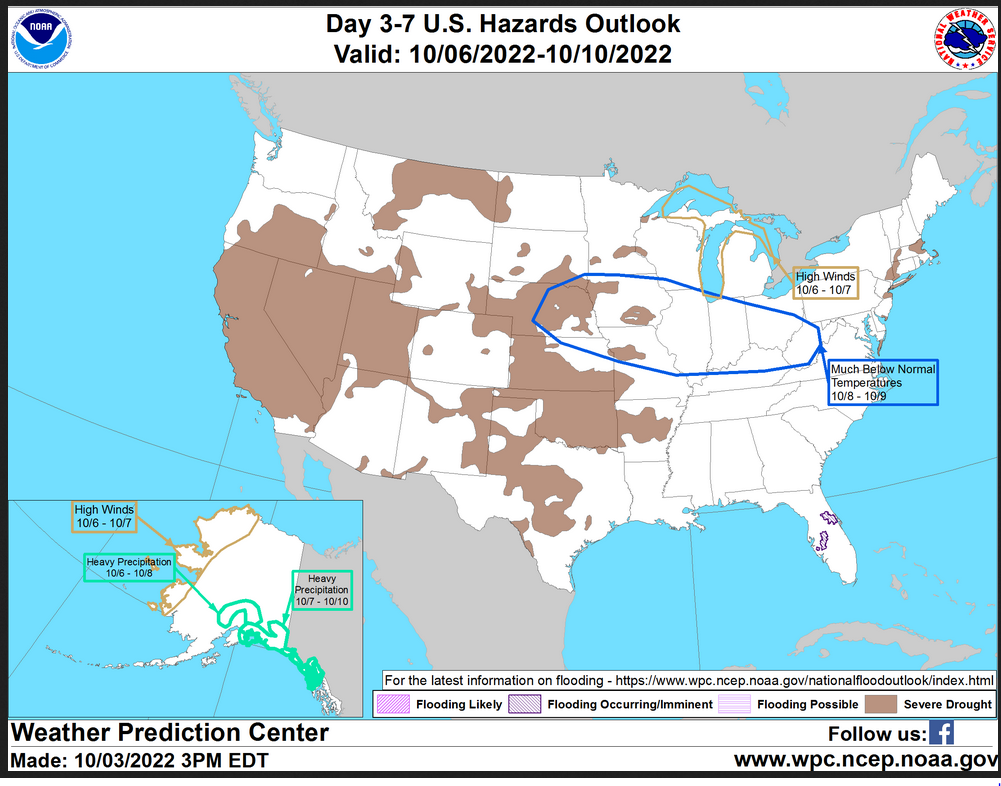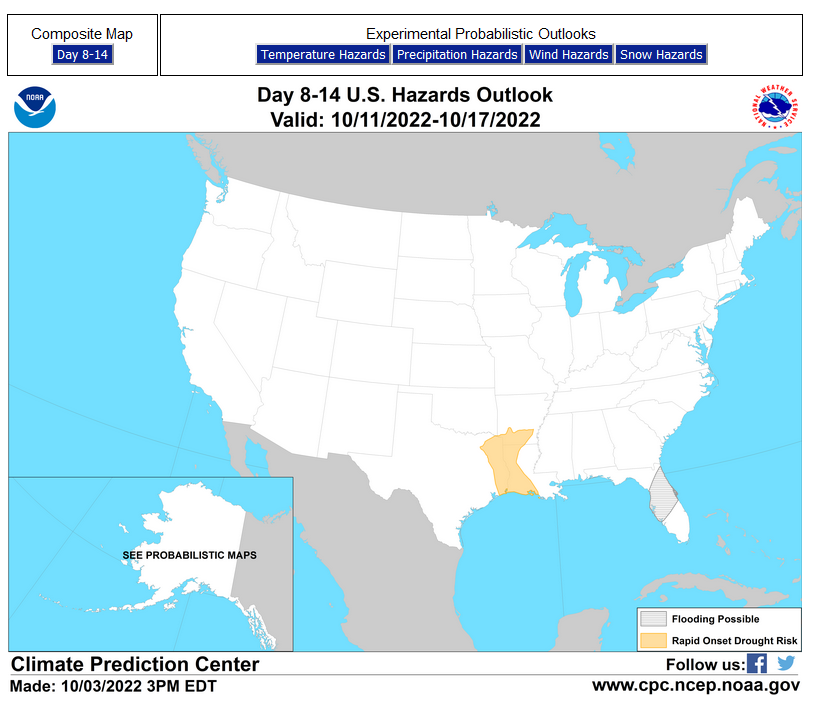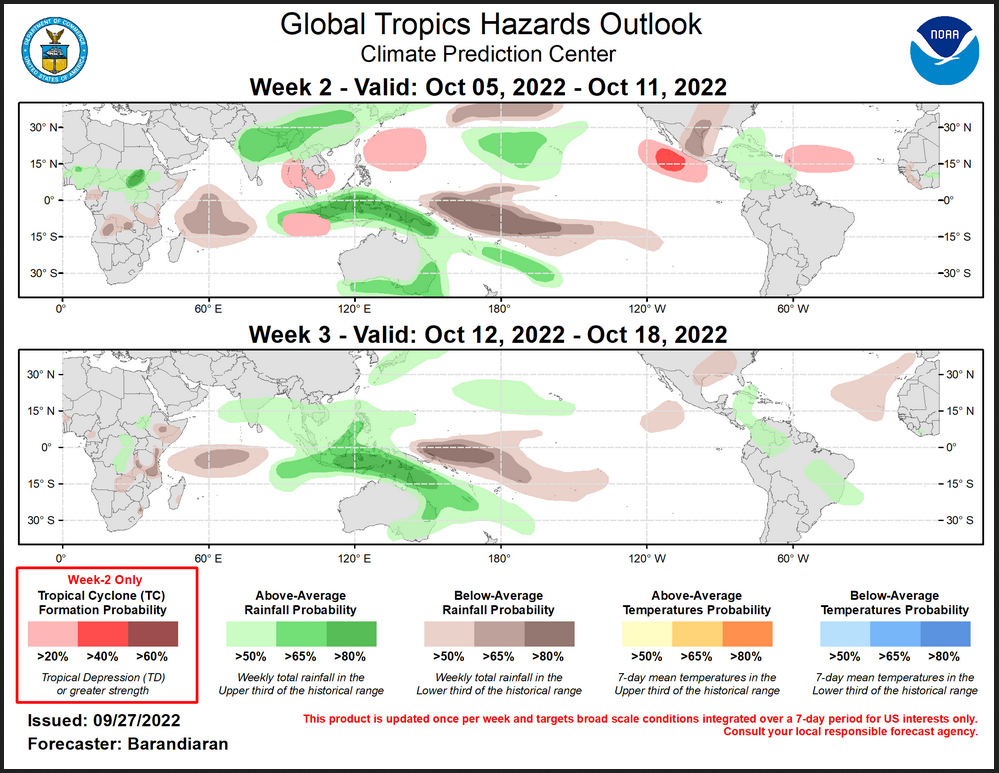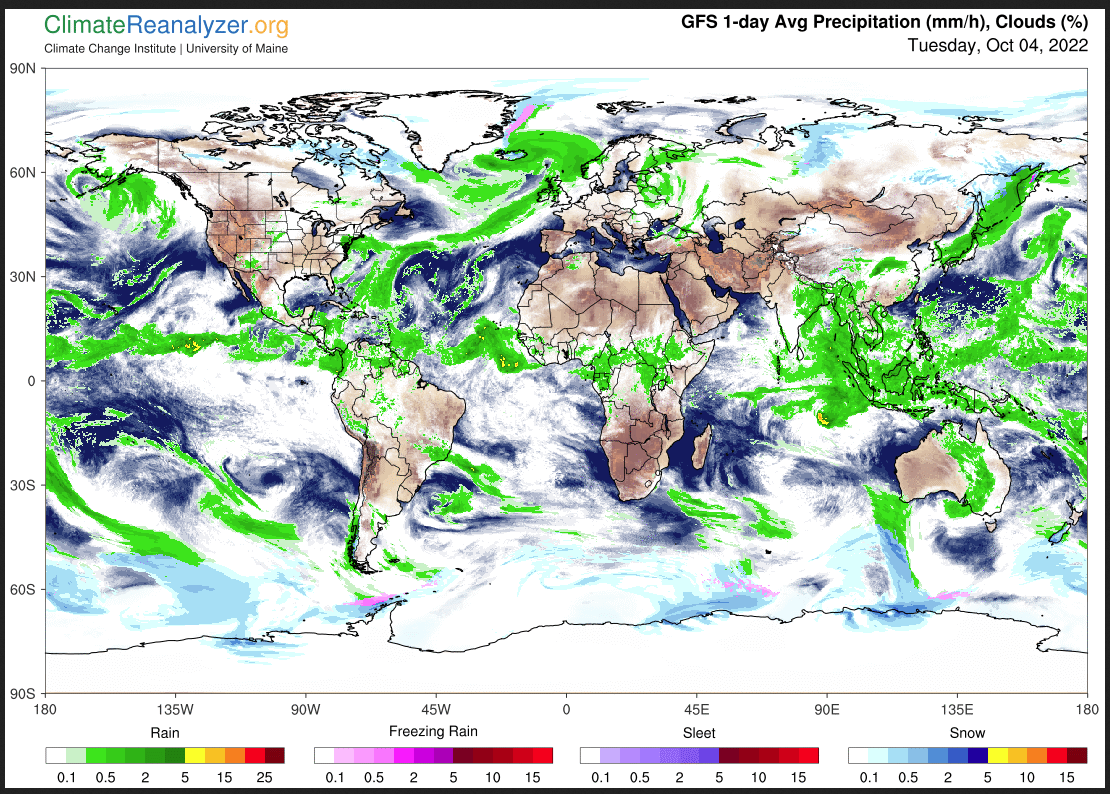Here is what we are paying attention to this evening and the next 48 hours from this afternoon’s NWS Forecast.
...Rainy, breezy, and cool conditions expand from Mid-Atlantic to southern New England coast... ...Showers and thunderstorms expected across much of New Mexico... ...Above average temperatures forecast for the West Coast, Great Plains and Mississippi Valley...
Continuation of the NWS Short Range Forecast (It is updated twice a day and these updates can be found here.
A stagnant upper-level low will slowly rotate from the Mid-Atlantic coast into the western Atlantic over the next couple of days. Showers and thunderstorms will slowly spread across the Mid-Atlantic coast today before shifting northward into parts of the New Jersey and New England coasts on Tuesday. The prolonged nature of this rain event may cause coastal flooding from southeast Virginia up into Long Island where Coastal Flood Advisories and Warnings are in effect. Cool and breezy conditions are expected to continue due to clouds and northerly flow into the region paired with a sharp isobaric gradient along the coast. High temperature records may be tied or broken across the Mid-Atlantic coast on Tuesday as highs fail to make it out of the 50s. Elsewhere, shortwave energy will supply sufficient moisture and instability to support shower and thunderstorm activity across much of New Mexico through Tuesday. Isolated flash flooding is possible over susceptible land surfaces. Light showers may focus along a weak cold front which is forecast to move through the Northern/Central Plains on Tuesday. An amplifying upper ridge will keep things clear and warm across much of the West with high temperatures likely to be between 10-20 degrees above average over the next few days. An upper trough swinging through the mid-section of the country will draw warm southerly air into the Plains and Mississippi Valley through Wednesday.
Current forecast of heavy precipitation (Updates can be found HERE)
Maps that relate the forecast to geography can be found by clicking Here for Day 1 and Here for Day 2.
Here is a 60-hour animated forecast map that shows how the short-term forecast is expected to play out
If it needs to be updated click here.
HAZARDS OUTLOOKS
Click here for the latest complete Day 3 -7 Hazards forecast which updates only on weekdays. Once a week probably Monday or Tuesday I will update the images. I provided the link for readers to get daily updates on weekdays. Use your own judgment to decide if you need to update these images.
Worldwide Tropical Forecast
(This graphic updates on Tuesdays) If it has not been updated, you can get the update by clicking here This is a new approach and covers weeks 2 and 3 not weeks 1 and 2. It has more information but I am having trouble getting used to it. As usual, it comes with a discussion which is below
Outlook Discussion Last Updated – 09/27/22
Valid – 10/05/22 – 10/18/22
Madden-Julian Oscillation (MJO) activity is increasing after a recent period of incoherent tropical convective activity. Tropical convection is coalescing into a wave 1-like pattern with enhanced(suppressed) convection over the Maritime Continent(Eastern Pacific) and modest eastward propagation of these features, especially the suppressed phase. Looking ahead, there is widespread agreement among dynamical model RMM-based forecasts for the high probability of an upcoming significant MJO event. The general consensus is that the RMM signal will emerge from the unit circle during the week-1 timeframe in phase 4 or 5 and amplify significantly while propagating slowly eastward during weeks 2-3. Tropical cyclone (TC) activity has been high over the last week. A pair of TCs formed south of Japan (Noru, 9/22; Kulap, 9/25). Noru became a strong typhoon and is currently moving toward the Vietnam coast, while Kulap has stayed out to sea and is set to become an extratropical system in the coming days. TC Newton formed in the East Pacific on 9/21 and dissipated quickly without affecting land. TC Ashley formed in the southern Indian Ocean 9/26 but is not expected to have any impacts to land. In the Atlantic Basin, TC Hermine formed near the Cape Verde Islands on 9/23 and quickly dissipated. Later on 9/23, TC Ian formed in the Caribbean Sea, and is currently near Cuba as an intensifying hurricane. Ian is anticipated to come ashore along the eastern Gulf Coast in the coming days with the potential for heavy rain and high winds during the next few days. Please refer to the National Hurricane Center (NHC) for more information and the latest forecasts.
Looking ahead to week 2, heightened MJO activity and the La Niña base state when coupled with a westerly wind burst over the equatorial Indian Ocean depicted in multiple dynamical models provide favorable conditions for TC formation on either side of the equator for the Eastern Indian Ocean. Model guidance from the ECMWF and GEFS also indicate heightened probabilities of TC formation during the week-2 time period covering a broad area in Philippine Sea, the Eastern Pacific Basin and the Main Development Region (MDR) of the Atlantic Basin.
The precipitation outlook for the next two weeks is based on anticipated TC tracks, ongoing La Nina conditions, and consensus of GEFS, CFS, and ECMWF ensemble mean solutions. Suppressed (enhanced) rainfall continues near and to the west of the Date Line (over the Maritime Continent) due to ongoing La Nina conditions and anticipated MJO phase. Below-normal precipitation is anticipated for the western tropical Indian Ocean for both weeks 2 and 3.
For hazardous weather conditions in your area during the coming two-week period, please refer to your local NWS office, the Medium Range Hazards Forecast produced by the Weather Prediction Center, and the CPC Week-2 Hazards Outlook. Forecasts made over Africa are made in coordination with the International Desk at CPC.
Detailed Maps and Reports for the Western Atlantic and the Pacific Oceans
Below are three maps that summarize the situation for the Atlantic, Eastern and Central Pacific. Additional information can be accessed by clicking H ERE
First the Atlantic
Click to view the forecast map and have access to additional information https://www.nhc .noaa.gov/gtwo.php?basin= atlc&fdays=5
Then Eastern Pacific
Click to view the forecast map and have access to additional information https://www.nhc.noaa.gov/gtwo.php?basin=epac&fdays=5
Then Central Pacific
Click to view the forecast map and have access to additional information https://www.nhc.noaa.gov/gtwo.php?basin=cpac&fdays=5
And the Western Pacific
Click to view the forecast map and have access to additional information https://www.metoc.navy.mil/jtwc/jtwc.html
Some Intermediate-Term Outlooks
Links to “Outlook” maps and discussions for three time periods. Days 6 – 10, Days 8 – 14, and Weeks 3 and 4. An outlook differs from a forecast based on how NOAA uses these terms in that an “outlook” presents information from deviation from normal and the likelihood of these deviations.
You have to click on the links because they do not update automatically and I do not want to have stale images in the article. But it is not difficult to click on a link and you get a large image plus a discussion. On Fridays in a separate article, we will show the images and provide a link in this article that article. But remember what you will see is the images as of Friday. But here you can get the current images simply by clicking on them. Then hit the return arrow at the upper left of your screen to return to the article. You will not find this information easily anywhere else.
Right now you can find these maps here (We show them every Friday there but you can click above and find them).
Worldwide Weather
Below is the current or short-term precipitation forecast which can be updated by clicking HERE Additional maps can be obtained HERE.
Month to Date Information
Month to date Temperature can be found at https://hprcc.unl.edu/products/maps/acis/MonthTDeptUS.png
Month to date Precipitation can be found at https://hprcc.unl.edu/products/maps/acis/MonthPNormUS.png

